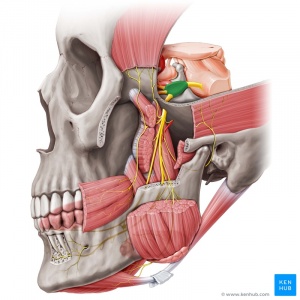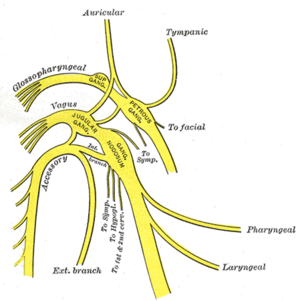A ganglion is a collection of neuronal bodies found in the voluntary and autonomic branches of the peripheral nervous system (PNS).
Ganglia can be thought of as synaptic relay stations between neurons. The information enters the ganglia, excites the neuron in the ganglia and then exits.
Among vertebrate animals there are three major groups of ganglia. These include:
- Dorsal root ganglia or spinal ganglia where the cell bodies of sensory or afferent nerves are located
- Cranial nerve ganglia that contain the neurons of the selected cranial nerves.
- Autonomic ganglia, which contain the cell bodies of the autonomic nervous system.
In addition to the ganglion of the peripheral nervous system, there are also parts of the brain that contains a cluster of interconnected nuceli called the basal ganglia
Structure
 |
| Ganglion (Neuroanatomy) |
Ganglia are oval in structure and contain
- Neuronal cell bodies (somata)
- Satellite glial cells, surround neurons in the sensory, sympathetic and parasympathetic ganglia and help regulate the chemical environment. They may contribute to chronic pain.
- A dense connective tissue capsule covers the ganglion, with a single layer of flat shaped satellite cells surrounding each neuronal cell body.
- A basement membrane covers the outer region of the satellite cells.
Three Major Groups Of Ganglia
- A spinal ganglion (dorsal root ganglion) is a cluster of nerve bodies positioned along the spinal cord at the dorsal and ventral roots of a spinal nerve. The dorsal root ganglia contain the cell bodies of afferent nerve fibres (those carrying impulses toward the central nervous system); efferent neurons (carrying motor impulses away from the central nervous system) are present in the ventral root ganglia.
- Cranial Nerve Ganglion (not all CN have) is analogous to the dorsal root ganglion, except that it is associated with a cranial nerve, instead of a spinal nerve (associated with the spinal cord). The roots of cranial nerves are within the skull, whereas the ganglia are outside the skull. Eg, The vagus nerve has two sensory ganglia, the superior and the inferior ganglia both outside the skull; the trigeminal ganglion is exterior to the temporal bone . Like the sensory neurons associated with the spinal cord, the sensory neurons of cranial nerve ganglia are unipolar in shape with associated satellite glial cells.
- There are two types of Autonomic Ganglia: the sympathetic and the parasympathetic based on their functions. The former tend to be located close to the spinal cord whereas the later lie near or within the viscera of the peripheral organs that they innervate.
Sensory ganglia
The cell bodies of somatic sensory and visceral sensory neurons are found in the dorsal root ganglia of spinal nerves, and on the ganglia of selected cranial nerves. Hence known as sensory ganglia.
1.Dorsal root ganglia:
- most common type of sensory ganglia. They are found in the posterior (dorsal) root of spinal nerves, following the emergence of the dorsal root, that emerges from the intervertebral neural foramina
- contain clusters of sensory neuron cell bodies which transmit messages relating to pain, touch, and temperature from the PNS, towards the CNS. Satellite glial cells separate and inhibit interaction between cell bodies in the ganglion.
- Most of the body’s sensory neurons are contained here.
Another type of sensory ganglia, are the ones that are found in the cranial nerves. Those are ganglia with special sensory functions and they are similar to the dorsal root ganglia except for they are associated with the cranial nerves and not the spinal nerves.
Key Facts
 |
| Ganglion (Neuroanatomy): |
Ganglion: Collection of neuron cell bodies located in the peripheral nervous system (PNS).
Types:
- Sensory ganglia: Dorsal root ganglia of spinal nerves and the ganglia of selected cranial nerves.
- Autonomic ganglia: Sympathetic (close to the spinal cord), Parasympathetic (near on in the viscera).

0Comments